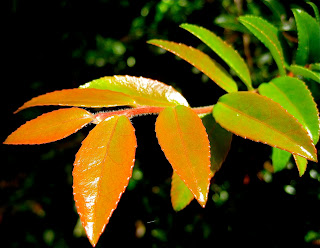Huckleberries are a delicious treat every fall. They are in the heather family (Ericaceae). Here in the PNW there are three common huckleberry species that we see whenever we walk a local trail or drive down the road. They do not look exactly alike, even though they are all edible. They differ in flower color and arrangement, fruit color and sweetness, leaves are similar yet very different, even the bark is different. But they are all shrubs growing in our coniferous forests feeding our wildlife. Below are a few differences to notice.
Black Huckleberry
(Vaccinium membranaceum)
Black huckleberry flowers are pink with dark bases. They are arguably the prettiest huckleberry flowers in the area. They are born solitaire from the leaf axil just like the red huckleberry. But there is no confusing flowers of the two species. As you will see below, the red huckleberry flowers are far more inconspicuous.
Evergreen Huckleberry
(Vaccinium ovatum)
Evergreen huckleberry flowers are mostly white or pinkish white but you will notice they have green bases. In fact, the evergreen huckleberry is the most unique of the three. The flowers are born in clusters at the leaf axils. People tend to rave about the delicious taste of black huckleberries. They often enjoy red huckleberries (my favorite) but few people go out of their way to collect evergreen huckleberries. The birds and wildlife certainly don't mind. There are plenty to go around.
Red Huckleberry
(Vaccinium parvifolium)
(red huckleberry flower above, fruit below)
Red huckleberries are delightfully bright in color. The inconspicuous flowers insure they do not get eaten before they can develop the most delicious fruit. Birds and many mammals enjoy the fruit. Both black and evergreen huckleberries have dark fruit. So there is no mixing them up with red huckleberry. And if you are not sure whether you are looking at fruit on the branch of a black huckleberry or an evergreen huckleberry, the difference is clear in the leaf.
Below are clear photographs of the evergreen huckleberry leaves. There are a lot of them on a branch, they have stiffly serrated margins, they are dark green (new growth red turning green) and leathery. Review the photographs above to observe the difference in leaves of the other two huckleberries. They are both much lighter green and more delicate to the touch. The main differences between them is that the black huckleberry leaves are larger than red huckleberry and have softly serrated margins where red huckleberry has smooth (entire) margins.
Huckleberries are not only delicious when in fruit but a tea can be made of their leaves. Drink the tea daily to stabilize blood sugar levels (check with your doctor). They are also delightful shrubs to have around because birds love to hide in them. Unfortunately, red huckleberry does not transplant well. It often takes up residency on rotting logs and trees. In fact, I always notice them on stumps of western redceders (Thuja plicata) alongside little hemlock (Tsuga heterophylla) seedlings. Black huckleberry usually grows at mid elevations so we won't often run into it on our lowland trails. But evergreen huckleberry makes a good hedge and is available for your garden at many nurseries in the PNW





